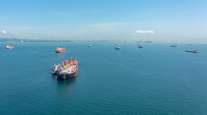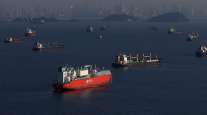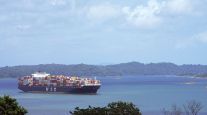Panama Canal Dispute With Contractors Won’t Delay Expansion, Official Says
This story appears in the Jan. 27 print edition of Transport Topics.
ATLANTA — The expansion of the Panama Canal will move forward on schedule, despite an ongoing dispute with contractors, an administrator for the Panama Canal Authority told transportation executives.
Construction is about 65% complete on the locks that will open the way for much larger container ships to pass through the canal and reach the U.S. East Coast, Deputy Administrator Manuel Benitez said Jan. 21 at SMC3’s “Jump Start 2014” conference.
Benitez said he expects no changes to the canal authority’s target of completing the project in the second half of 2015.
“All of the foundation is completed, so really, from here on, it’s much easier,” Benitez said. “I anticipate no further delay, even if the contractor fails to complete the project.”
The canal authority has finances available to continue with the project even if the contractor does not finish the work, he said.
The consortium building the expanded canal, however, said in a Jan. 20 statement that failure to reach an agreement to co-finance the additional costs would result in a “serious delay” for the project.
The canal authority’s dispute with contractors centers on about $1.6 billion in additional project costs beyond the original contract bid of $3.1 billion, according to a Bloomberg News report.
On Dec. 31, builders threatened to suspend work if the canal authority didn’t offer more compensation for those added costs. However, the chairman for Spanish firm Sacyr SA, part of the builder consortium, later said the work would be completed. Talks between the sides continued last week.
The new locks will allow ships that can carry up to 13,000 to 14,000 twenty-foot equivalent unit containers to pass through the canal, compared with today’s maximum vessel size of 5,100 TEUs, Benitez said.
“It’s all about economies of scale,” he said. “That’s what the expansion program is about — improving efficiency, productivity and profitability.”
He also stressed the importance of continued infrastructure enhancements for ports, roads and rail along the U.S. East and Gulf coasts.
“Unless the U.S East Coast ports can continue making the investments necessary . . . these ships won’t need to come through the Panama Canal,” he said. “We are betting that the U.S. East Coast ports and the Gulf ports are going to continue making investments to make the economies of scale for the shipping industry come to fruition.”
That work is already happening, with ports increasing harbor depths and adding cranes for larger ships, Benitez said.
The expansion of the Panama Canal will ultimately extend the influence of eastern U.S. ports to the Midwest, he said.
Benitez was introduced at the SMC3 conference by U.S. Rep. Lynn Westmoreland (R-Ga.), who said the nation faces a “serious problem” with “the age, the safety and the reliability of our infrastructure.”
“As you know, in the supply chain business or shipping business, if we don’t have good roads, if we don’t have good harbors, if we don’t have good rail systems, we’re not going to keep up with the economy,” he said.
Westmoreland also touted the planned deepening of the harbor at the Port of Savannah, which will enable it to accept the larger vessels that will be coming through the Panama Canal.
“We’re looking forward to seeing some of those new ships come through and head to the Georgia ports,” he said.
Benitez said 65% of the Panama Canal’s cargo traffic originates in or is destined for the United States.
About 10.5% of U.S. sea-borne trade passes through the canal, he said.
According to a November 2013 study by the U.S. Department of Transportation, the Panama Canal expansion will have the greatest effect on U.S. imports of containerized cargo from Asia.
The study concluded that a large swath of the country — stretching from Western New York and Detroit to Ohio, Kentucky, Tennessee and Alabama — could rely increasingly on East Coast ports as a result of the expansion.




